So you’re thinking about a gap year. Some time to experience the bigger world before settling into college or a career. A gap year can mean travel abroad, cultural exchange, an opportunity to backpack, volunteer, satisfy curiosities, experience new places, learn new skills … or all of the above!
Beginning of the Gap Year Popularity
Let’s pause for a moment and look back on the gap year concept. During the cultural and social upheaval of the 1960s in Britain, the “gap year” idea became popular as the younger generation questioned the establishment. They took time out to explore new avenues and new paths in life. Many took a year off after school to travel through Europe or Asia with a backpack and little more. They explored how they might want to live. They discovered a richness of experience, and found it in other cultures, in the outdoors, in volunteering and in trying out new ways of being in the world.
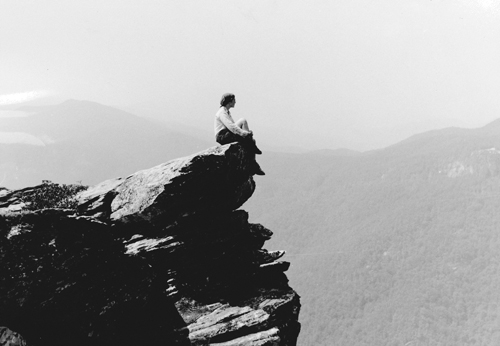
Early photo of an Outward Bound student on course in North Carolina.
The gap year idea has evolved over the decades. Today, many young adults around the world take time off from school or work to expand their horizons and consider what direction they’d like to go next in their lives. As outdoor recreation has grown, the adventure and allure of the wilderness offers a way to accomplish gap year goals. For many employeers and college admissions offices, a well-planned gap year is a major plus on a student’s or prospective employee’s resume. It shows the person has taken initiative to explore passions, learn about other people and places, and stretch themselves.
Meet the Semester Course
Following the same gap year spirit, Outward Bound has been offering semester courses for many years. From sailing in the Florida Keys to climbing a volcano in Ecuador, canyoneering in the Southwest or learning to be an instructor in the outdoors, these gap year courses provide the opportunity to stretch and grow, develop leadership and self-confidence, and an appreciation for the natural world. All are based on wilderness expeditions, and some include an international component in Brazil, Ecuador, Costa Rica, the Bahamas or Patagonia.
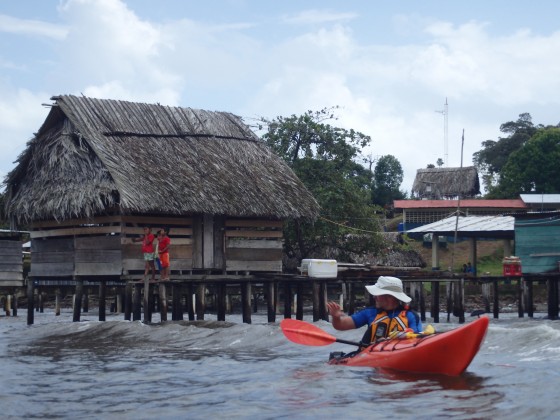
An Outward Bound Gap Year student kayaks overseas during the Florida Keys to Costa Rica Leadership semester.
A semester expedition runs from 50 to 85 days, depending on the course you choose. They have certain core pieces in common:
- Wilderness travel: Whether traveling with a pack on your back, or all your provisions in a canoe, raft or sail boat, your group will be self-sufficient as it navigates through spectacular terrain. Between expeditions, you’ll have a short break before packing up for the next adventure.
- Multiple activities: Each course offers the chance to master several outdoor activities, whether it’s a combination of backpacking, rock climbing and canoeing, or sailing, trekking and canyoneering. As you peruse the various course options, you’ll see a host of activities to choose from.
- Service component: Service projects are an important component of a gap year semester course. They offer the chance to interact with people whose lives are different from yours, and to help make a difference. Sometimes projects are with public land managers like the U.S. Forest Service or a conservation organization. Other projects are with local social service agencies like soup kitchens or Habitat for Humanity. Projects overseas offer the chance to work together with locals in the community.
- Leadership development: On a semester course, Instructors teach skills at the beginning: first aid, navigation, packing, campcraft and more. Over time, responsibility for group organization and leadership is turned over to the group. Individuals rotate leadership, under the guidance of Instructors. There’s nothing like experience and conversation about leadership to understand it in depth.
- Multi-day solo: A chance to rest the body after adventure and activity, and to contemplate all that you’ve learned. Most students love solo; you’ll have your own campsite to reflect, write in your journal, and savor solitude in a beautiful place.
- Physical fitness and personal challenge: Expeditions require hard work, and you’ll get stronger and stronger as you carry a pack, paddle and portage a canoe, or row the sailboat. You’ll feel stronger as the course progresses, and participate in a personal challenge event at the end. This could be a distance run, paddle or swim. By the time you get to the personal challenge, you’ll be ready to see what you can do!
A Rich Menu of Options
Each semester course is different. Some include an international expedition. Others offer certifications like Wilderness First Responder or SCUBA. Some are designed for those who would like to instruct courses in the outdoors, an experiential “teacher training.”
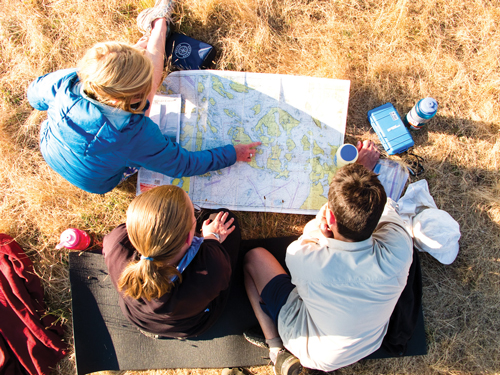
Students map out their route on course with Outward Bound. Photo by Joel Reid
Think about what your goals are for your gap year, and if outdoor adventure and wilderness travel are on your list, there’s a good chance Outward Bound has a course that would be a good fit for you.
The Florida Keys to Brazil Leadership Semester begins with a sailing expedition, where you’ll learn coastal navigation on a traditional 30-foot sailboat. During this first expedition, Instructors teach technical skills and guide the group through the early stages of working together. The group switches gears to earn a Wildernes First Responder Certificate, recognized as the standard of care for wilderness programs.
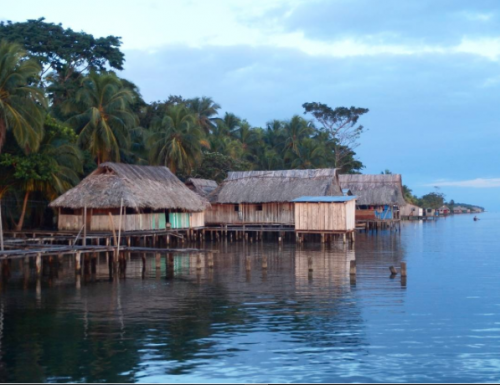
Students spend time in small villages off the coast of Brazil during their semester with Outward Bound.
You’ll then prepare for a backpacking trip in Brazil. You’ll trek for several days to a village where you’ll spend time with local families and assist with projects in the community. A rock climbing clinic introduces you to the basics of technical climbing. You’ll earn a Swiftwater River Certification canoeing, then begin a final three-week expedition where your group will use everything you’ve learned up to that point.
The Maine to Bahamas Environmental Semester begins in the wilderness of the northern Appalachian mountains in Maine, where you’ll learn backpacking, rock climbing, and canoeing skills on pristine lakes and rivers. The course then moves to a totally different climate, activity and natural environment — the subtropics, where sailing is the mode of transportation and the coastal waters of Florida serve as the outdoor classroom. You participate in long running scientific research projects at Cape Eleuthera Institute in the Bahamas, and volunteer in the local community.
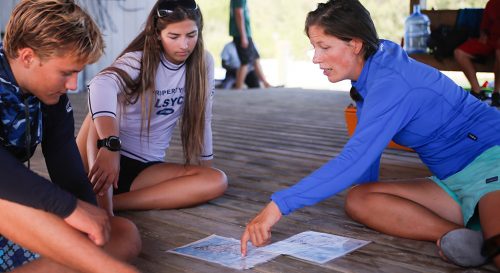
Students learn navigation techniques in the Bahamas. Photo by The Island School
You’ll have the chance to work with professional scientists, graduate students and professors on one of four ongoing research projects. This course also includes Wilderness First Responder certification, the standard of care required for those working in wilderness settings, and a very useful skill set for life anywhere.
The Rockies to Ecuador Leadership Semester begins with the basics of backpacking and backcountry navigation, and continues to build skills in mountaineering in the Rockies, then canyoneering in Utah. Here, the night skies will amaze you as much as the exquisite scenery of canyon country. A climbing component in the beautiful and unique Joshua Tree National Park completes the U.S. portion of the trip. You’ll then immerse in the colorful culture of Ecuador while preparing to attempt the climb of an 18,000 foot volcano, a chance to use all the skills you’ve developed since starting in Colorado.
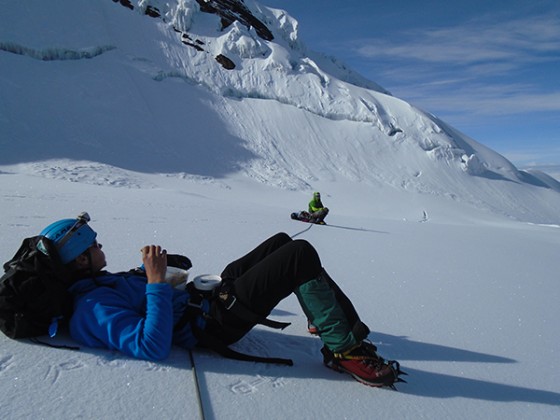
Taking in the scenery while mountaineering in Ecuador with Outward Bound.
Instructor Development Courses are perfect if you are thinking of working in outdoor adventure programs. 35 to 52 days in length, these training programs begin with a short Outward Bound course, so that the participants know first hand what Outward Bound is like from a student perspective. Wilderness First Responder certification is included, the standard of care for professionals in the field to know how to handle any emergency that may arise. Students gain in-depth training in interpersonal skills and group management, as well as outdoor activities, such as rock climbing, paddling, backcountry navigation, etc. These courses are a strong foundation, along with personal experience in the outdoors, for a career in the field.
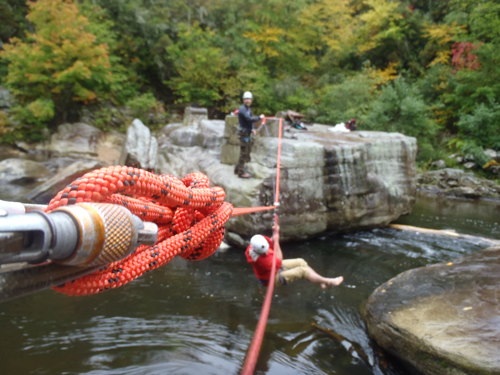
Students cross a river during an Instructor Development course in the Blue Ridge Mountains.
Why Take a Gap Year?
A well-used gap year can enhance your chance at the job you hope for, or the college you’d really like to attend. It shows that you’ve taken initiative to learn about the bigger world, and mastered skills that aren’t available in a classroom. Whichever activities and course environment you choose for an Outward Bound semester course, you can expect to be challenged as well as supported, and to have adventures you’ll remember for the rest of your life!
Some Final Words
“…As someone once reminded me, and as I now remind each incoming class at Princeton, ‘the person each of you will spend most of the rest of your life with is yourself, and therefore you owe it to yourself to use your college years to become as interesting a companion as possible.’ But I am also convinced that one’s college education is greatly enhanced by the more maturity, experience, and perspective a student can bring to it.
Alas, it strikes me that these three traits are the very ones that are most difficult for most young people to come by given the lock-step nature that currently characterizes such a large part of the school-to-college process… Indeed, of all the enthusiastic letters I send to students in one year, none are more enthusiastic than those I send in response to students requesting to defer their entrance to college.”
-Fred A. Hargadon, former Dean of Admissions, Princeton
To learn more about Outward Bound, visit www.outwardbound.org or call 866.467.7651. With a rich selection of expeditions, a wide variety of age groups, stunning locations, and courses that run throughout the year, there’s an Outward Bound expedition for everyone.
About the Author
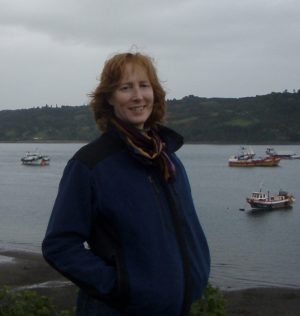
CJ Wilson
CJ Wilson is a former Outward Bound Instructor whose gap year experience included a semester studying language and culture in Spain, then traveling by foot, bus, and train throughout Europe. Today she writes from her base camp in Asheville N.C.
OTHER POSTS YOU MAY LIKE
Read More
Read More
Read More




